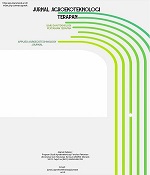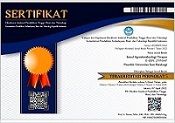Analysis Model Approach Of The Rate Change Of Absorption And Cooking Loss Of Dry Noodles Made From Cassava Starch
DOI:
https://doi.org/10.35791/jat.v4i2.47867Abstract
Noodle from Cassava starch (mie singkong) is alternative noodle nonwheat flour. That is the manufacturing process really on gelatinization and retrogradation of this starch to form a strong structure matrix. The objective is to make an approach analysis model of the rate change of absorption and cooking loss of dry noodles made from Cassava starch, there for the model can be used for predicting water absorption and cooking loss in various temperatures in the drying proses. This research uses Completed Randomized Design (CRD) one factorial, drying temperatures 50,60,70,80, and 900 C with two repetitions. Calculation using Software Microsoft Excel and Completed Randomize Design (CRD) one factorial at level 5% using the application SPSS (Statistical Product and Service Solutions). The formula for making dry cassava noodles uses a ratio of manufactured tapioca flour to traditional flour of 3: 2 (60%: 40%) and the addition of water 76% of the total tapioca. The tests carried out were water content, water absorption, and cooking loss. The results obtained are Exponential Decay; Modified Single, and three parameters. Otherwise done organoleptic test was carried out using a preference test for color, texture, and overall preference. The result of the research shows that the predicted water content equation is Kapred = 0,3062*exp(5,2641/(x +-16,292)) with R2 = 0,7121; the predicted water absorption equation is DSApred = 1,5690/(1+exp(-(x-28,5824)/ 0,9613)) with R2 = 0,8096 and the predicted cooking loss equation CLpred = y0+5,138*exp(-0,1136*x) with R2 = 0,8145, with x = temperature (o C) and preference test for color, texture and overall preference not significantly different at all temperature treatments.
Keywords: tapioca, dry cassava noodle, predicted water content, water absorption, and cooking loss.
Abstrak
Mie singkong merupakan mie alternatif yang bahan dasarnya pati singkong (tapioka) non terigu yang pembuatannya mengandalkan proses gelatinisasi dan mekanisme retrogradasi untuk membentuk jaringan struktur mie yang kokoh. Tujuan penelitian ini adalah melakukan pendekatan model analisis laju perubahan daya serap dan cooking loss mie singkong (Manihot utilissima ) kering, sehingga model tersebut dapat dipergunakan untuk memprediksi daya serap air dan cooking loss pada berbagai suhu pengeringan. Penelitian ini menggunakan Rancangan Acak Lengkap (RAL) dengan satu faktor yang digunakan yakni perlakuan suhu pengering (50,60,70,80, dan 900C ) dengan 2 kali ulangan. Data dianalisa menggunakan Software Microsoft Excel dan Rancangan Acak Lengkap (RAL) pada taraf 5% dengan menggunakan program aplikasi SPSS (Statistical Product and Service Solutions). Formula pembuatan mie singkong kering menggunakan perbandingan tepung tapioka pabrikan dengan tepung tapioka tradisional 3:2 (60%: 40%) dan penambahan air 76 % dari total tapioka. Pengujian yang dilakukan yaitu kadar air, daya serap air dan cooking loss. Hasil yang didapat dihitung menggunakan Exponential Decay; Modified Single, 3 Parameter. Selain itu dilakukan uji organoleptik menggunakan uji kesukaan terhadap warna .tekstur dan kesukaan secara keseluruhan. Hasil penelitian menunjukkan persamaan kadar air prediksi adalah Kapred = 0,3062*exp(5,2641/(x +-16,292)) dengan R2 = 0,7121 ; Daya Serap air prediksi DSApred = 1,5690/(1+exp(-(x-28,5824)/ 0,9613)) dengan R2 = 0,8096 dan Cooking Loss prediksi CLpred = y0+5,138*exp(-0,1136*x) dengan R2 = 0,8145 dengan x = suhu pengeringan (oC) ; Uji kesukaan terhadap warna dan tekstur mie kering tidak berbeda nyata pada semua perlakuan suhu.
Kata kunci: tapioka, mie singkong kering, prediksi kadar air,daya serap, cooking loss.
Downloads
Published
How to Cite
Issue
Section
License
Copyright (c) 2023 Henny Krissetiana Hendrasty, R. Sugiarto, Sundari Setyaningsih, Ika Kurniasih

This work is licensed under a Creative Commons Attribution-NonCommercial 4.0 International License.

This work is licensed under a Creative Commons Attribution-NonCommercial 4.0 International License.





















